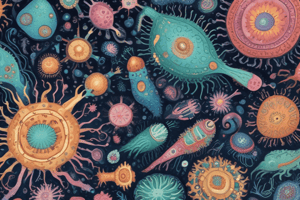Podcast
Questions and Answers
What are protozoan organisms composed of?
What are protozoan organisms composed of?
- Organs
- Multiple cells
- Tissues
- One protoplasmic mass (correct)
Which type of protozoa has characteristics of both plants and animals?
Which type of protozoa has characteristics of both plants and animals?
- Mastigophore (correct)
- Ciliates
- Sarcodina
- Foraminiferans
What is the locomotory organ of Mastigophore?
What is the locomotory organ of Mastigophore?
- Flagellum (correct)
- Cilia
- Fins
- Pseudopodia
Which of the following diseases is caused by Leishmania?
Which of the following diseases is caused by Leishmania?
Which protozoan group has organisms with pseudopods?
Which protozoan group has organisms with pseudopods?
What causes Amoebic dysentery?
What causes Amoebic dysentery?
In which environments are protozoa found?
In which environments are protozoa found?
What forms the pseudopods in Sarcodina?
What forms the pseudopods in Sarcodina?
Which protozoan group forms calcareous or siliceous shells?
Which protozoan group forms calcareous or siliceous shells?
How do Dinoflagellates move?
How do Dinoflagellates move?
What is the general characteristic of protozoa?
What is the general characteristic of protozoa?
Where are protozoa NOT typically found?
Where are protozoa NOT typically found?
Which of the following distinguishes mastigophores?
Which of the following distinguishes mastigophores?
Which type of protozoa is known for having both plant and animal characteristics?
Which type of protozoa is known for having both plant and animal characteristics?
What feature do Sarcodina use for locomotion?
What feature do Sarcodina use for locomotion?
What are the ectoplasm and endoplasm?
What are the ectoplasm and endoplasm?
What is a defining feature of free-living protozoa?
What is a defining feature of free-living protozoa?
Which protozoan is known to cause Amoebic dysentery?
Which protozoan is known to cause Amoebic dysentery?
Which group of protozoa is believed by biologists to be closely related to animals?
Which group of protozoa is believed by biologists to be closely related to animals?
Which of the following environments do foraminiferans typically inhabit?
Which of the following environments do foraminiferans typically inhabit?
Flashcards are hidden until you start studying
Study Notes
Protozoa
- Protozoa are microscopic organisms that can be either free-living or parasitic, with a single mass of protoplasm making up their bodies.
- Despite their small size, protozoa are complex organisms that perform all the functions of life, which require coordination between multiple organs.
Habitat and Distribution
- Protozoa are found in a wide range of environments, including:
- Fresh and saltwater
- Soil
- Moist areas
- Brackish water, hot springs, and even glacial ice
- Many protozoa live as parasites on invertebrate or vertebrate animals, or on various plants.
Classification
- Protozoa are divided into four main groups based on their mode of locomotion:
- Mastigophora (flagellates)
- Sarcodina (amoebae)
- Ciliophora (ciliates)
- Sporozoa (sporozoans)
Mastigophora (Flagellates)
- Mastigophora are extremely small, possessing both plant-like and animal-like characteristics.
- They are characterized by the presence of a flagellum, a whip-like structure used for movement.
- Unicellular, with a single flagellum emerging from the front of the body (e.g., Euglena)
- Flagellum can be double, with one flagellum wrapping around the body and into specific grooves (e.g., Dinoflagellates)
- Examples of Mastigophora include:
- Leishmania, which causes Leishmaniasis in humans and other vertebrates
- Trypanosoma cruzi, which causes African sleeping sickness
Sarcodina (Amoebae)
- Sarcodina are small, single-celled organisms that can change shape.
- They consist of a protoplasmic mass with:
- An outer, transparent layer called ectoplasm
- An inner layer called endoplasm, which can transform into the other through a process called gel-sol-transformation
- They can form temporary or permanent protrusions called pseudopodia, used for movement.
- Examples of Sarcodina include:
- Entamoeba histolytica, which causes amoebic dysentery in humans
- Free-living Foraminiferans, which live in oceans and form calcium or silica skeletons, contributing to the formation of petroleum-rich sediments.
Protozoa
- Protozoa are microscopic organisms that can be either free-living or parasitic, with a single mass of protoplasm making up their bodies.
- Despite their small size, protozoa are complex organisms that perform all the functions of life, which require coordination between multiple organs.
Habitat and Distribution
- Protozoa are found in a wide range of environments, including:
- Fresh and saltwater
- Soil
- Moist areas
- Brackish water, hot springs, and even glacial ice
- Many protozoa live as parasites on invertebrate or vertebrate animals, or on various plants.
Classification
- Protozoa are divided into four main groups based on their mode of locomotion:
- Mastigophora (flagellates)
- Sarcodina (amoebae)
- Ciliophora (ciliates)
- Sporozoa (sporozoans)
Mastigophora (Flagellates)
- Mastigophora are extremely small, possessing both plant-like and animal-like characteristics.
- They are characterized by the presence of a flagellum, a whip-like structure used for movement.
- Unicellular, with a single flagellum emerging from the front of the body (e.g., Euglena)
- Flagellum can be double, with one flagellum wrapping around the body and into specific grooves (e.g., Dinoflagellates)
- Examples of Mastigophora include:
- Leishmania, which causes Leishmaniasis in humans and other vertebrates
- Trypanosoma cruzi, which causes African sleeping sickness
Sarcodina (Amoebae)
- Sarcodina are small, single-celled organisms that can change shape.
- They consist of a protoplasmic mass with:
- An outer, transparent layer called ectoplasm
- An inner layer called endoplasm, which can transform into the other through a process called gel-sol-transformation
- They can form temporary or permanent protrusions called pseudopodia, used for movement.
- Examples of Sarcodina include:
- Entamoeba histolytica, which causes amoebic dysentery in humans
- Free-living Foraminiferans, which live in oceans and form calcium or silica skeletons, contributing to the formation of petroleum-rich sediments.
Studying That Suits You
Use AI to generate personalized quizzes and flashcards to suit your learning preferences.




